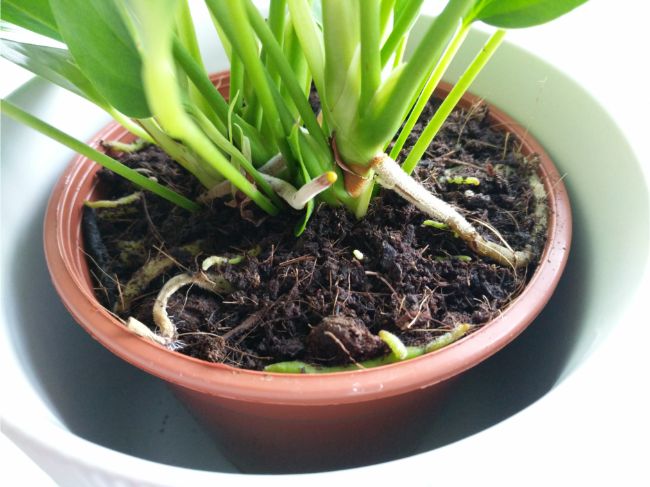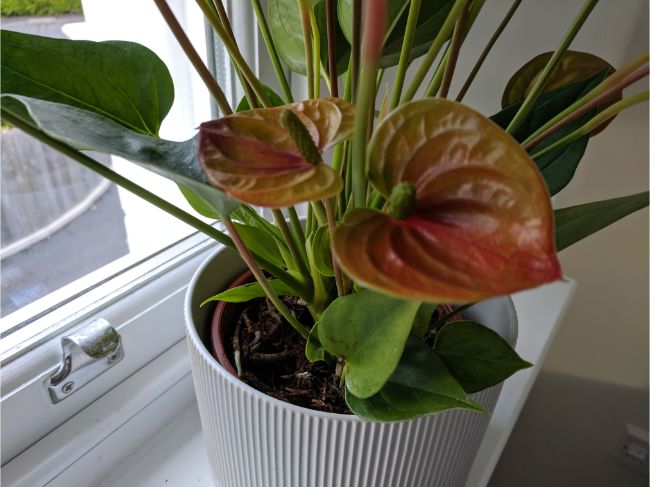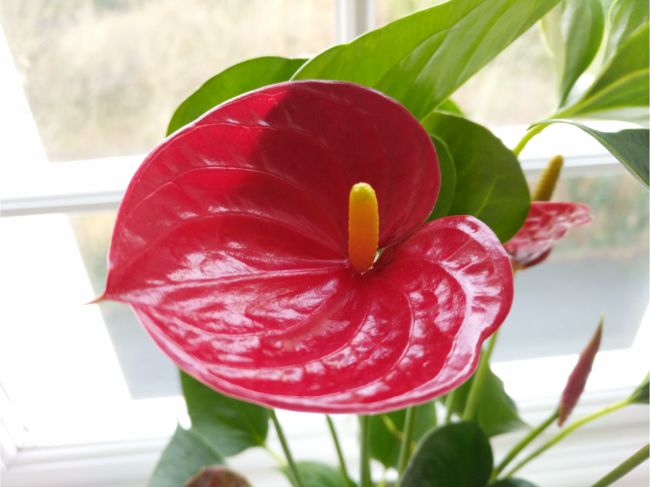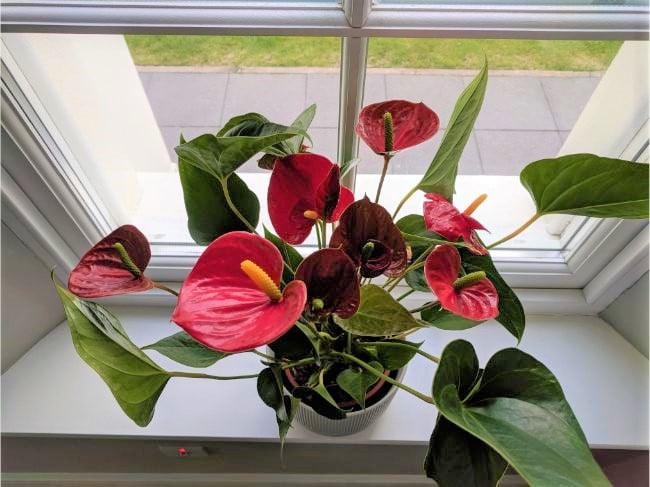Anthuriums are known for their showy, exotic flower bracts that come in vibrant shades of red, pink, and white, and often flower year-round. So if your anthurium is not flowering despite producing foliage that appears healthy, it can be very frustrating.
Why is my anthurium not flowering? Anthuriums are picky about their environment, and issues like soggy soil or insufficient lighting can prevent them from blooming. Encourage your anthurium to bloom by providing lots of indirect sunlight, proper watering, high humidity, and weekly feeding with diluted phosphorus-rich fertilizer.
In this article, we will take a look at the various issues that could be preventing your anthurium from flowering and discuss what you can do to correct any problems and encourage your plant to bloom.
If you’d like to keep all your houseplants blooming and thriving year after year, check out my book, “Houseplants Made Easy”.
Anthurium Houseplant Care Basics
The best way to get your anthurium houseplant to bloom is to make sure you are providing it with the growing environment it prefers.
Anthuriums are tropical rainforest plants, and most common houseplant varieties are epiphytic in nature, meaning they grow on trees in the same way orchids and bromeliads do. And much like orchids, they are rather picky about their environment.
This doesn’t mean they are difficult to grow; it just means you need to find a good spot in your home for your potted anthurium and make sure you are giving it everything it needs so it has the energy to produce those eye-catching blooms. This brief summary outlines the basic elements of how to care for an anthurium houseplant.
Anthurium Houseplant Care Summary:
- Potting mixture: Well-draining peat-based or pine bark potting mixture
- Light: All day bright indirect sunlight
- Temperature: 70-85 °F (21-29 °C)
- Humidity: High
- Watering: Allow potting mixture to dry out slightly between watering
- Fertilizing: Feed weekly with high-phosphorous liquid fertilizer diluted to 10-20% strength
- Repotting: Every two years
For more detail about caring for Anthurium houseplants, see my in-depth guide here.
In the following sections, we will go through each of these elements of anthurium care to help you identify problems that may be the reason why your anthurium isn’t blooming.
Is Your Anthurium Planted In The Right Potting Mixture?
One reason why an anthurium houseplant won’t bloom could be the type of potting mixture it’s growing in. If you aren’t using a very well-draining potting mixture, then the soil is probably not draining fast enough each time you water it.
Waterlogged potting mix can drown the roots by preventing them from being able to absorb oxygen. This weakens the plant and deprives it of the energy it needs for blooming, as well as causing root rot.
Remember that in nature, these anthuriums grow on rainforest trees; so although they receive lots of rain, their roots are exposed to the air rather than being buried in soil. These plant roots are specially adapted to cycles of rain that come and go, and they will not tolerate soggy soil.
To maintain healthy anthurium growth and sustain consistent flowering, use a potting mixture made for orchids, or make your own well-draining peat-based or pine bark potting mixture that includes growing media such as perlite or volcanic rock to ensure that the roots are always well aerated.
And of course, make sure your plant’s container has drainage holes in the bottom.

Lighting Is The Most Common Cause Of An Anthurium Not Flowering
One of the most common reasons why anthurium houseplants don’t bloom is insufficient light.
Anthuriums can survive and even produce vigorous foliage in lower lighting conditions, but they won’t flower if they don’t have lots of bright indirect sunlight. Your plant should be in a location where it receives bright but diffuse light all day long rather than for just a couple of hours a day.
If you don’t have a place in your home or office that gets enough light, use a full-spectrum grow light to make sure your anthurium receives excellent lighting for 9 hours a day so you can enjoy the vibrant flowers that make these plants such a wonderful addition to your home.

This Temperature Issue May Be Preventing Your Anthurium From Flowering
The temperature range for these tropical plants is a comfortable 70-85 °F (21-29 °C), so anthuriums are generally happy in most indoor settings – that is, as long as the plant is not exposed to drafts and other sudden temperature changes.
Anthuriums are very sensitive to the rapid changes in temperature that can occur if they are located near an external door or window or close to heating and cooling vents. Exposure to drafts also adversely affects anthuriums, as will air suddenly blown directly at them from a room or exhaust fan cycling on.
So getting your anthurium houseplant to flower may be as simple as relocating a fan or finding a spot where your plant is protected from these types of local temperature changes.
Anthuriums And Humidity
Anthuriums need a moist environment, so be sure to maintain high humidity around your plant. Lack of humidity will cause the foliage to lose its sheen, which is an adaptation to the moist rainforest environment, and will reduce your plant’s resilience along with its ability to flower.
To keep your anthurium’s local humidity level high, group your houseplants or place a humidifier nearby. You can also set the plant on a humidity tray, which is simply a shallow tray filled with pebbles and water such that the pot doesn’t come in contact with the water.
Read this article I wrote about how to create perfect humidity conditions for your houseplants.
Note that, with so much moisture in the air, you need to balance the high humidity with some air movement to prevent mold, fungus, and insect infestations.
So be sure to place a gently blowing fan nearby, but don’t allow it to send air directly at the plant. In addition to the sudden temperature changes, too much airflow will quickly dry your anthurium out and can scorch the foliage. You just want to ensure that there is some air circulation in the area around the plant.
Proper Watering Will Make Your Anthurium Flower
Another problem that may be preventing your anthurium houseplant from flowering is improper watering.
Since anthuriums love moisture, it may seem logical to conclude that you need to maintain plenty of water in the potting mixture. But as mentioned before, their roots are used to being exposed to air and don’t do well in soggy soil. On the other hand, too little water will also harm your plant and its ability to flower.
So what is the proper amount of water for potted anthuriums?
What you should do with anthuriums is water the potting mixture thoroughly, allow the excess water to drain out, and then, checking the moisture with your finger or a wooden stick, water again when the soil has dried out a bit but without allowing it to become completely dry.
Depending on the local climate, weather conditions, time of year, size of the plant, and other factors, you may need to water every day, every couple of days, or about once a week. For example, you will most likely need to water more frequently in the hot summer months than in the cooler seasons.

The “Weakly, Weekly” Fertilization Method Will Help Your Anthurium Bloom
While epiphytic anthuriums growing in the wild don’t have the benefit of natural soil processes that deliver nutrients to the plants, they constantly gain small amounts of dissolved minerals and nutrition from rainwater, decayed vegetation, and other forest debris.
You can mimic nature and give your plant the nutritional boost it needs for flowering by feeding your potted anthurium small amounts of phosphorous-rich liquid fertilizer once a week. Look for a fertilizer that’s formulated for flowering plants, dilute it to a weak 10-20% strength, and add it to the soil after watering or spray it on the foliage. It’s a method known as “weakly, weekly,” and it may be just what your anthurium needs to get it to bloom.
Does Your Anthurium Need Repotting To Help It Bloom?
Over time, your anthurium’s potting mixture will begin to break down and become compacted, which will deprive the roots of oxygen. Also, leached salts from the fertilizer can build up in the soil. These soil conditions could cause your anthurium stress and prevent it from flowering.
To avoid these problems, repot your anthurium every two years or so. Anthurium roots like to be somewhat pot-bound, so don’t increase the pot size by much, if at all. And conversely, don’t repot simply because the roots have filled the pot.
Other reasons why your anthurium may need repotting are if you have it in the wrong type of potting mixture and/or the roots have become damaged from soggy soil or too much watering – which will stress the plant and deprive it of the energy required for blooming.
Last Word
Hopefully, these tips will help you get your Flamingo Flower well on the way to blooming again. It’s such a beautiful flowering houseplant, so your efforts will be well rewarded. If you’d like to learn more about caring for Anthurium houseplants, I’ve written a more in depth guide to looking after these wonderful plants.

